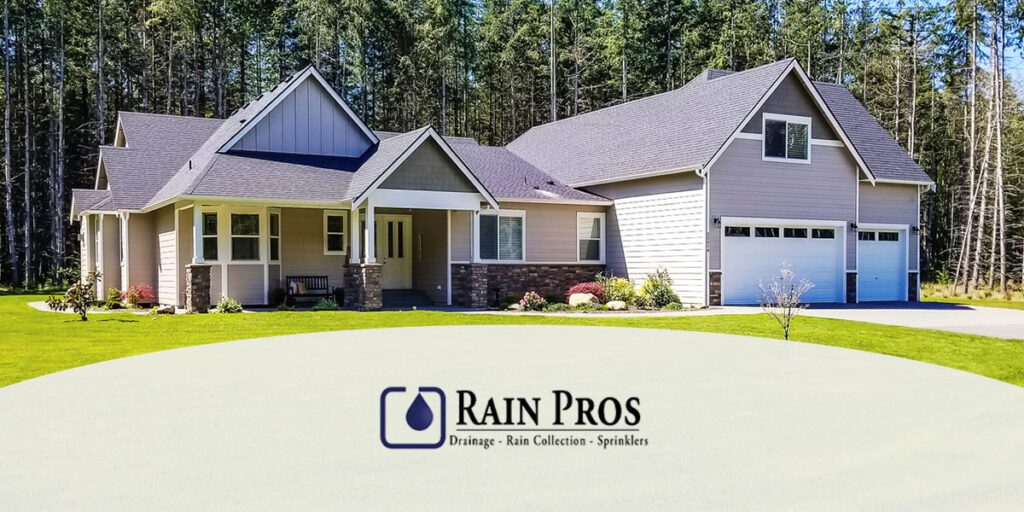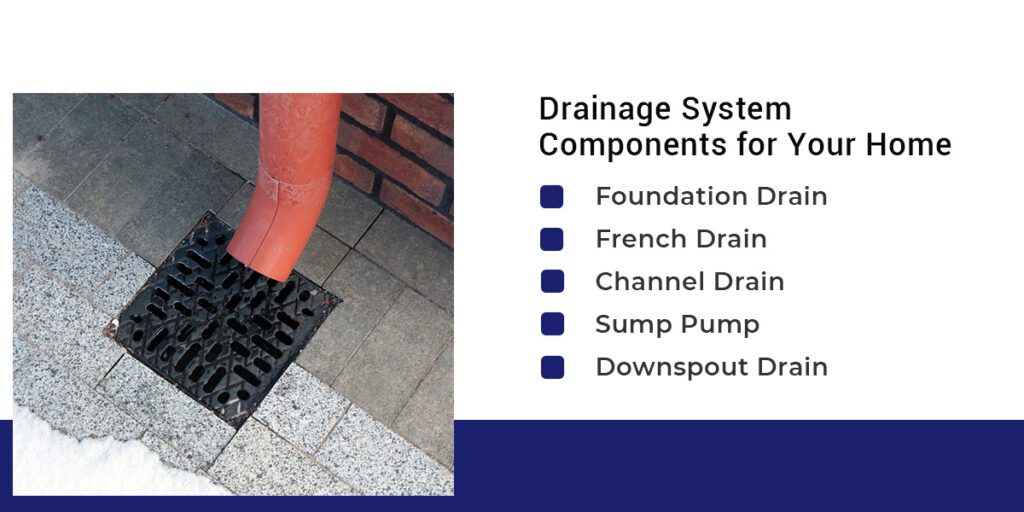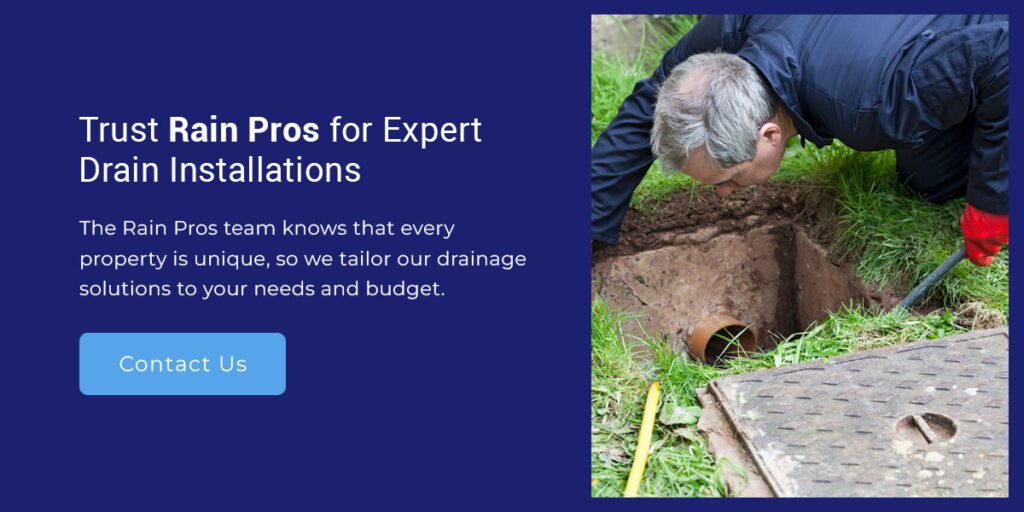What Drain Is Right for Your Home?

You invest a lot of time in maintaining your home, so it pays to know how to prevent water damage from compromising your hard work. While leaks, flooding and pooling can be unpredictable, you can control the outcome.
Drainage systems offer a solution for limiting and preventing water damage so you can preserve your property and investments. Knowing the ins and outs of the different types of drains available can help you select the right design for your home and budget.
Types of Drainage Systems
Drainage systems can protect your home from flooding if excess moisture starts to accumulate near the structure. Placing drain elements in areas such as on the roof, below the basement and around the foundation provides a method of directing water away from your home.
Strategically placed drainage solutions will prevent water from pooling and allowing rot and mold to develop, helping you minimize the risk of structural damage and preserve your home. The following are a few common classifications of drainage systems that use different components to collect and redirect water.
Surface Drainage
To manage surface drainage, professionals dig parallel drains in shallow or ground-level trenches. When it rains, the trenches act as tunnels for water to run through, collecting and guiding it away from your home. A surface drainage system is essential for flat and high-precipitation areas, as it will help minimize excess groundwater and prevent puddling.
Subsurface Drainage
A subsurface drainage system requires deep trenches, pipes and a collection point. The pipes sit right beneath the soil’s top layer and carry excess water away from waterlogged earth. The chute collects water from the pipes and guides it away from your home to prevent accumulation. French drains are common in subsurface drain solutions.
Slope Drainage
A slope drainage system carries water away from your home through a downward channel. Here, the pipes lay on an incline or slope and direct excess water downward. In slope systems, gravity moves water down the pipes, so these designs are best suited for areas that sit at a greater altitude than the primary water management system.
Gutter Drainage Systems
Gutter drainage systems collect rainwater and prevent excess moisture from building up on your roof. Gutters funnel water through sloped downspouts onto designated ground areas to direct it away from the home. These installations protect your house by moving water away from the foundation before it can cause rot and other damage.

Drainage System Components for Your Home
While drainage systems all accomplish the same goal, they use different components and design elements to direct water away from where it poses a risk to a structure. Understanding different types of drains can help you select a suitable solution for your home.
Foundation Drain
Foundational drains, also called foot drains, are usually installed underground during the early stages of construction, often under your home or basement foundation. Foundational pipes are meant to last as long as the house itself and are made with durable materials like PVC to help prevent corrosion and wear. To create a foot foundation drain, professionals layer a trench around your home perimeter with concrete or stone before installing the pipes.
With the pipes in place, another layer of material is layered over them and then secured with the foundation to prevent water from seeping into your home. The pipes below the foundation collect excess water and channel it away to prevent pooling, dampness and structural damage.
French Drain
French drains create a subsurface channel for water to flow through. Professionals can use various techniques for installing French drains, though the process typically involves placing a perforated pipe into a deep trench full of gravel. The pipe is directed to a safe point well away from the home, and its perforations face down to allow it to collect and redirect any excess water that builds up beyond the initial gravel layer. The installer places more gravel over the top of the pipe to conceal it while still allowing runoff to enter the trench.
When it rains, water seeps through the gravel layers and follows the trench to the exit point. Depending on the structure, the pipe may deposit the runoff into a drain collector, dry well or low-lying area far from the structure.
To increase the volume of water that enters the redirection pipe, you can install a geotextile layer in the trench before placing the first layer of gravel. Geotextile fiber also provides additional protection by staving off creeping roots and keeping the pipe free of soil and silt. Though they’re common outdoors, you sometimes find French drain systems inside the home to carry water to a basement sump pump for discharge.
Channel Drain
Channel or trench drains provide a system for draining water away from your garage, inground pool, walkways and pavements. Here, professionals install a channel under pavement or a sidewalk and secure a drain in place with cement. The drain is connected to multiple underground pipes that direct water to an opening like a drainage ditch or low-lying area. A channel drain can offer a convenient and affordable drainage solution that has minimal impact on your property’s appearance.
Sump Pump
Sump pumps can expel moisture from your home when it seeps in as a result of excess groundwater. Homeowners often install sump pumps in their basements to safely direct water outside before it can result in flooding. This solution involves placing a pump in a basin — a hole that sits below the level of the basement floor to collect water — and giving it an outlet that directs water away from the home’s foundation.
Sump pumps generally trigger automatically by means of a float switch when the system detects a set amount of groundwater. These home water management solutions come in several varieties, including pedestal and submersible models, and are considered essential for homes in areas with a high risk of flooding.
Downspout Drain
The downspout is a major component of your gutter drainage system. This piece helps collect runoff from your roof and route it away from your home. Downspouts can come in various shapes and are typically found on an exterior wall in an isolated area, where they connect to your gutter system and run to the ground to expel water.
When it rains, water and debris collect in your gutters and filter through your downspout pipes. The sloped position guides the water toward a drainage ditch or storm sewer, protecting the home’s foundation. Often, these pieces empty into a downspout drain to control the flow of water more effectively and filter out debris like leaves and shingle granules. A downspout drain may be routed underground to keep runoff contained until it reaches the preferred discharge point.

Trust Rain Pros for Expert Drain Installations
Get customized drain solutions from the experts at Rain Pros. Whether you need a simple downspout drain or a foundation drainage system with a sump pump for new construction, we have the expertise to help you decide which drain is right for your home. Our professionals are here to keep your flooding and foundation damage risks to a minimum.
The Rain Pros team knows that every property is unique, so we tailor our drainage solutions to your needs and budget. For assistance with choosing the best drainage solution for your home, get in touch with us online.
